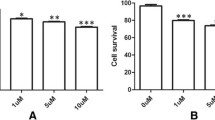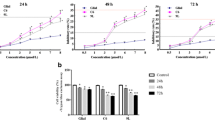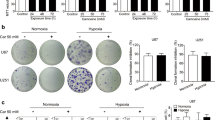Abstract
Purpose
Glutamine is an essential amino acid for the synthesis of glutathione (GSH), the major endogenous antioxidant which protects cells from oxidative injury. To evaluate the effects of glutamine concentrations, cell growth, GSH levels, oxidative stress, and chemosensitivity were evaluated in neuroblastoma cell lines.
Methods
Three human neuroblastoma cell lines (SMS-KCNR, SMS-KANR, SMS-LHN) were cultured with different concentrations of glutamine (2, 0.2 and 0 mM) under hypoxic (5% O2) or normoxic (20% O2) condition. Cell proliferation and chemosensitivity were determined by MTT assay, and the levels of intracellular GSH were measured by DTNB-GSSG reductase method. Cellular reactive oxidative species (ROS) were quantified by flow cytometry.
Results
There was a significant decrease of cell growth in low glutamine (0.2 and 0 mM) compared with control (2 mM) in all three cell lines (P < 0.01), while adding GSH partially restored the reduced cell proliferation by low glutamine. The levels of GSH in neuroblastoma cells decreased significantly in low glutamine compared with the levels of control cells cultured in 2 mM glutamine (P < 0.05), and the accumulation of cellular ROS was significantly higher in 0 mM glutamine compared to the control. Moreover, glutamine deprivation significantly enhanced cytotoxicity of L-PAM in all three cell lines, which was abolished after addition of GSH.
Conclusion
Glutamine deprivation decreased cell proliferation and enhances cell chemosensitivity in neuroblastoma, which is presumably associated with GSH depletion.







Similar content being viewed by others
References
Anderson CP, Tsai JM, Chan W, Park CK, Tian L, Lui RM, Forman HJ, Reynolds CP (1997) Buthionine sulfoximine alone and in combination with melphalan (L-PAM) is highly cytotoxic for human neuroblastoma cell lines. Eur J Cancer 33:2016–2019
Anderson CP, Seeger RC, Matthay KK et al (1998) Pilot study of buthionine sulfoximine (BSO) and melphalan (L-PAM) in children with recurrent neuroblastoma. Proc Am Soc Clin Oncol 17:531
Anderson CP, Tsai JM, Meek WE, Liu RM, Tang Y, Forman HJ, Reynolds CP (1999) Depletion of glutathione by buthionine sulfoxine is cytotoxic for human neuroblastoma cell lines via apoptosis. Exp Cell Res 246:183–192
Benlloch M, Mena S, Ferrer P, Obrador E, Aseni M, Pellicer JA, Carretero J, Ortega A, Estrela JM (2006) Bcl-2 and Mn-SOD antisense oligodeoxynucleotides and a glutamine-enriched diet facilitate elimination of highly resistant B16 melanoma cells by tumor necrosis factor- and chemotherapy. J Biol Chem 281:69–79
Carretero J, Obrador E, Pellicer JA, Pascual A, Estrela JM (2000) Mitochondrial glutathione depletion by glutamine in growing tumor cells. Free Radical Biol Med 29:913–923
Chang WK, Yang KD, Shaio MF (1999) Lymphocyte proliferation modulated by glutamine: involved in the endogenous redox reaction. Clin Exp Immunol 117:482–488
Curi R, Lagranha CJ, Doi SQ, Sellitti DF, Procopio J, Pithon-Curi TC (2005) Glutamine-dependent changes in gene expression and protein activity. Cell Biochem Funct 23:77–84
Fernandes RS, Cotter TG (1994) Apoptosis or necrosis: intracellular levels of glutathione influence mode of cell death. Biochem Pharmacol 48:675–681
Frenkel K, Gleichauf C (1991) Hydrogen peroxide formation by cells treated with a tumor promoter. Free Radic Res Commun 12–13(Pt 2):783–794
Fuchs BC, Bode BP (2006) Stressing out over survival: glutamine as an apoptotic modulator. J Surg Res 131:26–40
Green JA, Vistica DT, Young RC, Hamilton TC, Rogan AM, Ozols RF (1984) Potentiation of melphalan cytotoxicity in human ovarian cancer cell lines by glutathione depletion. Cancer Res 44:5427–5431
Gurney JG, Ross JA, Wall DA, Bleyer WA, Severson RK, Robison LL (1997) Infant cancer in the U.S.: histology-specific incidence and trends, 1973 to 1992. J Pediatr Hematol Oncol 19:428–443
Herrlich P, Bohmer FD (2000) Redox regulation of signal transduction in mammalian cells. Biochem Pharmacol 59:35–41
Jögi A, Øra I, Nilsson H, Lindeheim A, Makino Y, Poellinger L, Axelson H, Påhlman S (2002) Hypoxia alters gene expression in human neuroblastoma cell lines toward an immature and neural crest-like phenotype. Proc Natl Acad Sci USA 99:7021–7026
Jögi A, Øra I, Nilsson H, Poellinger L, Axelson H, Påhlman S (2003) Hypoxia-induced dedifferentiation in neuroblastoma cells. Cancer Lett 197:145–150
Kang YJ (1993) Buthionine sulfoximine spares intracellular glutamate: a possible mechanism for cell growth stimulation. Cell Mol Biol Res 39:675–684
Kang YJ, Freng Y, Hatcher EL (1994) Glutathione stimulates A549 cell proliferation in glutamine-deficient culture: the effect of glutamate supplementation. J Cell Physiol 161:589–596
Meister A (1991) Glutathione deficiency produced by inhibition of its synthesis, and its reversal; applications in research and therapy. Pharmacol Ther 51:155–194
Neu J, Shenoy V, Chakrabarti R (1996) Glutamine nutrition and metabolism: where do we go from here? FASEB J 10:829–837
Oehler R, Roth E (2003) Regulative capacity of glutamine. Curr Opin Clin Nutr Metab Care 6:277–282
Roth ER, Oehler R, Manahart N, Exner R, Wessner B, Strasser E, Spittler A (2002) Regulative potential of glutamine-relation to glutathione metabolism. Nutrition 18:217–221
Schroder CP, Godwin AK, O’Dwyer PJ, Tew KD, Forman HJ, Reynolds CP (1996) Glutathione and drug resistance. Cancer Investig 14:158–168
Soh H, Wasa M, Wang HS, Fukuzawa M (2005) Glutamine regulates acid transport and glutathione levels in a human neuroblastoma cell line. Pediatr Surg Int 21:29–33
Tew KD, Houghton PJ, Houghton JA (1993) Preclinical and clinical modulation of anticancer drugs. CRC, Boca Raton, pp 13–17
Todorova VK, Harms SA, Kaufmann Y, Luo S, Luo KO, Babb K, Klimberg VS (2004) Effect of dietary glutamine on tumor glutathione levels and apoptosis-related proteins in DMBA-induced breast cancer of rats. Breast Cancer Res Treat 88:247–256
Vandeputte C, Guizon I, Genestie-Denis I, Vannier B, Lorenzon G (1994) A microtiter plate assay for total glutathione and glutathione disulfide contents in cultured/isolated cells: performance study of a new miniaturized protocol. Cell Biol Toxicol 10:415–421
Wasa M, Bode BP, Abcouwer SF, Collins CL, Tanabe KK, Souba WW (1996) Glutamine as a regulator of DNA and protein biosynthesis in human solid tumor cell lines. Ann Surg 224:189–197
Author information
Authors and Affiliations
Corresponding author
Rights and permissions
About this article
Cite this article
Izaki, S., Goto, H. & Yokota, S. Increased chemosensitivity and elevated reactive oxygen species are mediated by glutathione reduction in glutamine deprived neuroblastoma cells. J Cancer Res Clin Oncol 134, 761–768 (2008). https://doi.org/10.1007/s00432-007-0338-2
Received:
Accepted:
Published:
Issue Date:
DOI: https://doi.org/10.1007/s00432-007-0338-2




